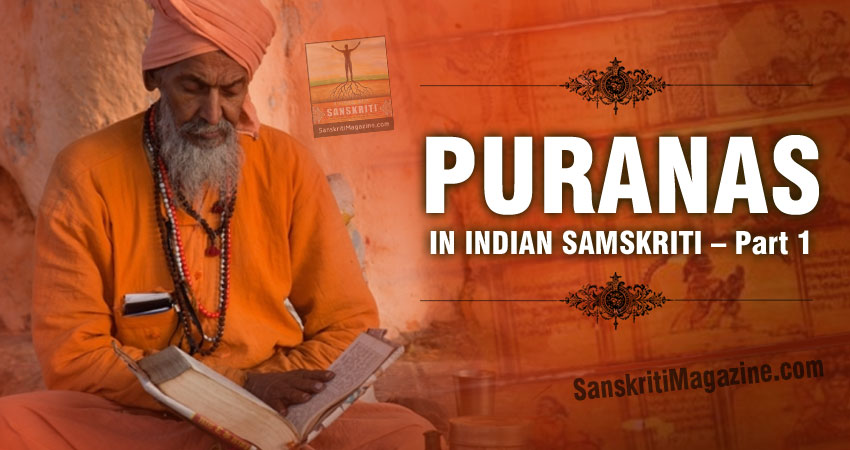The Vedas, the Mahabharata, the Ramayana and the Puranas may be said to constitute India’s cultural history, particularly of the Hindus. While the epic poems Ramayana and Mahabharata come under the category of Itihasa in Sanskrit literature, Puranas form a separate class. Importance of Puranas to Indian culture is not so much because of their literary merit as because, through them, we can trace the evolution of Indian thought in all aspects of life: political, social and religious. The influence of Puranas on the religious life of Hindus is beyond question, is both extensive and intensive. This is evidenced from the fact that mere study and recitation of Puranas are considered as acts of piety by large sections of Hindu community even today.
PURANAS:
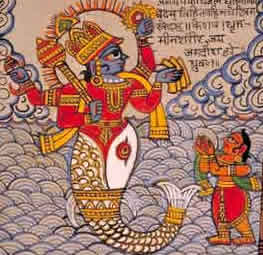 The word Purana means ‘old’ implying an ancient legend or tale. True to this meaning, Puranas were in existence since very early times and predate Mahabharata. This is inferred from occurrences of the term Purana in many ancient texts such as the Brahmanas and the Upanishads where it is used in the sense of cosmogonic enquiries and ancient tales. In Upanishads, Puranas have been called the fifth Veda (Panchama Veda). The Mahabharata refers to the Puranas and recounts several tales (ancient legends, stories of gods, pedigrees of sages) from them. Apasthamba Dharmasutra contains quotations from Purana which are not to be found in the current Puranas. These very old and original Puranic works were, however, lost.
The word Purana means ‘old’ implying an ancient legend or tale. True to this meaning, Puranas were in existence since very early times and predate Mahabharata. This is inferred from occurrences of the term Purana in many ancient texts such as the Brahmanas and the Upanishads where it is used in the sense of cosmogonic enquiries and ancient tales. In Upanishads, Puranas have been called the fifth Veda (Panchama Veda). The Mahabharata refers to the Puranas and recounts several tales (ancient legends, stories of gods, pedigrees of sages) from them. Apasthamba Dharmasutra contains quotations from Purana which are not to be found in the current Puranas. These very old and original Puranic works were, however, lost.
CURRENT MODERN PURANAS:
In place of the lost old Puranas, what we have to-day are 18 large treatises (Tri-Shat) that are designated as Puranas. They are the (major/maha) Puranas, are all written in Sanskrit verses and their lengths vary greatly; Skanda being the longest with 81,000 verses and Markandeya (9000 verses) the shortest. According to Bhagavata Purana, the total number of couplets in all the eighteen Puranas is 400,000.
One list of these eighteen Puranas is:
- Brahma
- Padma
- Vishnu
- Siva
- Linga
- Garuda (Suparna)
- Narada
- Bhagavata (Bhagavatam)
- Agni
- Skanda (Kartika)
- Varaha
- Brahma-Vaivarta
- Matsya
- Kurma
- Markandeya
- Bhavishya
- Vamana; and
- Brahmanda, Puranas.
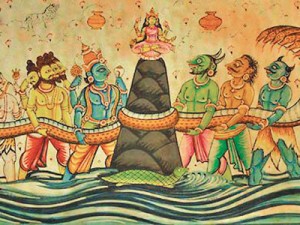 There are lists which omit one or more, and replace them by another such as, for instance, Vayu Purana takes the place of Agni or Shiva Purana. The list of 18 is sometimes enlarged to 19 to include Vayu, and to even 20 to include the Vayu Purana and the Harivamsa. According to Vishnu and some other Puranas, there was originally only one Purana: the Purana Samhita by Vyasa, and from this ONE, the 18 Puranas have grown. All the Puranas seem to have received additional revisions since each one of them enumerates the entire system.
There are lists which omit one or more, and replace them by another such as, for instance, Vayu Purana takes the place of Agni or Shiva Purana. The list of 18 is sometimes enlarged to 19 to include Vayu, and to even 20 to include the Vayu Purana and the Harivamsa. According to Vishnu and some other Puranas, there was originally only one Purana: the Purana Samhita by Vyasa, and from this ONE, the 18 Puranas have grown. All the Puranas seem to have received additional revisions since each one of them enumerates the entire system.
In addition to the above 18 Puranas, there are an equal number of Upa-Puranas or minor/subordinate Puranas. The main among them are the Narasimha Purana, Vayu Purana, Ganesha Purana, Kalika Purana, Kapila, Mudgala and Samba.
The 18 Puranas are classified in three categories depending on which of the three qualities of purity or truth (sattva), blind passion (rajas) and impurity, gloom or ignorance (tamas) is dominant and which god from the Hindu Trinity of gods is glorified.
Those in which the qualities of sattva prevail are:
- The Vishnu,
- the Narada,
- the Garuda,
- the Varaha,
- the Bhagavata,
- and the Padma Puranas.
These are the Vaisnava Puranas in which the god Vishnu is exalted to glory and they are termed the Sattvika.
Those in which rajas prevail are classified as Rajasa. They are:
- the Brahma,
- the Brahmanda,
- the Brahma-Vaivarta,
- the Markandeya,
- the Bhavishya
- and the Vamana Puranas
which relate chiefly to the worship of Brahma.
The remaining Puranas, namely, the Shiva, the Linga, the Skanda, the Agni/the Vayu, the Matsya and the Kurma in which tamas predominates are called Tamasa and the supreme god of devotion is Siva.
DATE OF THE PURANAS:
These eighteen Puranas were written over different periods of time or ages and the circumstances of their composition were different. No dates are attached to them, but there are evidences to show these Puranas to be not that very ancient as the word Purana might suggest.
Lexicographer AmarSimha, in his book AmarKoshah, defines Purana as a work that deals with five distinguishing marks or topics (Pancha-lakshanam), namely,
- Primary creation, cosmogony or the creation of the universe (Sarga);
- Secondary creation, mostly Pralaya (deluge, dissolution) and re-creation of world including chronology (Prati-Sarga);
- Genealogy of gods and patriarchs (Vamsa);
- The epochs of Manus’ Rule (Manvantarani), that is creation of human race and the first human beings; and
- Historical details of the solar and lunar races and their descendants (Vamsanucharitam).
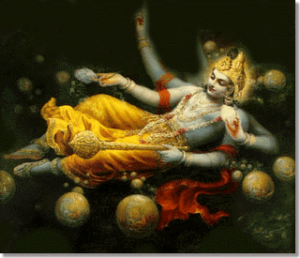 But, there is no one Purana whose form agrees entirely to the above definition of a Purana. Second evidence that significantly reduces the antiquity of these Puranas comes from the circumstances stated, authorities cited, legends narrated, or places particularized. Kumarila Bhatta of 8th century CE talked of Puranas as sources of law. Sri Shankaracharya of 9th century CE and Sri Ramanuja of the 12th century CE recognized the authority of Puranas.
But, there is no one Purana whose form agrees entirely to the above definition of a Purana. Second evidence that significantly reduces the antiquity of these Puranas comes from the circumstances stated, authorities cited, legends narrated, or places particularized. Kumarila Bhatta of 8th century CE talked of Puranas as sources of law. Sri Shankaracharya of 9th century CE and Sri Ramanuja of the 12th century CE recognized the authority of Puranas.
Even Alberuni in 1030 CE gives a list of the 18 Puranas and shows his familiarity with Vayu, Matsya and Vishnu Puranas. Another evidence in support of a comparatively modern date must be admitted for Puranas like Vayu, Bhagavata and Matsya in which it is foretold what dynasties of kings will reign in the Kali age. Reference is made to the Maurya dynasty in Vishnu Purana and to the Gupta dynasty in Vayu Purana. Lastly, the attribution to individual and personal deities of the qualities of the one universal Supreme Being indicates, for the Puranas, a later date than the Vedas, the Ramayana and the Mahabharata. Rama of Ramayana, although an incarnation of Vishnu, appears in human character. But in Mahabharata, there is something of the kind of deification in respect to Krishna, especially in the philosophical episode, the Bhagavat Gita. In most other situations in which Krishna is exhibited in action, it is not as a divinity.
The above internal evidences in conjunction with similar other evidences like frequent references to Buddhism and other religions, the style of writing and the highly artificial nature of stories have made scholars agree that these Puranas were written much later than Mahabharata: after 1st century CE up to 10th century CE, the more important of them composed before 7thcentury CE. The most recent and the most popular of the Puranas, the Bhagavata Purana was written after the 10th century CE.
CONTENTS AND CHARACTERISTICS OF THE PURANAS:
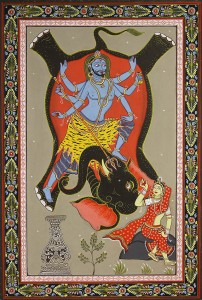 All the Puranas are written in the form of dialogue between an expounder and an enquirer. As example, Pulastya receives the Vishnu Purana from Brahma, makes it known to Parasara (expounder) who narrates it to Maitreya (enquirer). The compositions of the Puranas are not homogeneous like the Mahabharata to which they are indebted much in matter and spirit. Most of these Puranas were originally sung by bards like the Suta Pauranika who belonged to the class of people called Sutas. Later on, priests, finding them popular and of much use for a number of things, took control of them, modified them and finally monopolized them.
All the Puranas are written in the form of dialogue between an expounder and an enquirer. As example, Pulastya receives the Vishnu Purana from Brahma, makes it known to Parasara (expounder) who narrates it to Maitreya (enquirer). The compositions of the Puranas are not homogeneous like the Mahabharata to which they are indebted much in matter and spirit. Most of these Puranas were originally sung by bards like the Suta Pauranika who belonged to the class of people called Sutas. Later on, priests, finding them popular and of much use for a number of things, took control of them, modified them and finally monopolized them.
The original Puranas, written prior to Mahabharata, dealt with non-sectarian matter: origin of the universe and tales derived from the common myths and legends that have been popular from the Vedic times. The new Puranas too deal with theogony and cosmogony, but they are not described in detail. In some they are referred to, in others they are omitted entirely. These Puranas borrow the scheme of primary creation from Samkhya philosophy. Their accounts of secondary creation, and matter related to evolution and universe are derived from several other sources. Other topics included are the geographical and political divisions of the country, stories of incarnations, the different schools of metaphysical thought and the various religious creeds, names of cities and places of pilgrimages.
One characteristic that is common to all the Puranas is their pantheism. All of them, partially or fully, dwell upon the leading principles, rites and observances of the Hindu religion and illustrate them by suitable legends, prescribe the ceremonies to be practiced, the prayers and invocations to be employed in the worship of different deities. A particular divinity/deity is raised to the status of a Supreme Being and that divinity is diversified according to individual sectarian bias. The notion of one Supreme Being, in all likelihood, has come from the Vedas; but here in the Puranas, the Universal Being is of a higher order than a personification of attributes or elements. In the Pauranic faith, this Supreme Being manifests in the person of Siva or Vishnu, and consequently, each Purana is distinctly Vaishnavite or Saivite and extols everything associated with that deity (Siva or Vishnu): rituals, ceremonies, fasts and feasts, pilgrimages, exploits of that deity as the only path to salvation (Moksha).
CONCLUSION:
The Puranas are supplementary explanation of Vedas in as much as they expand upon and modify the orthodox Brahminism of the Vedas to the popular Hinduism of today. Puranas were composed at considerable distance of time from the two epic poems; but, by the time, the Puranas first began to be composed, belief in individual and personal deities has become the principal mark of Hindu religious belief or faith, and it continues to be so more or less. This mythic structuring of Indian culture has undoubtedly given sectarian character to Hinduism and we can see the marks of sectarianism in all walks of life, everywhere and all over India. Puranas are not rational texts. To understand them correctly, we need a different kind of imagination and interpretation. The most distinguishing feature of Pauranik Hinduism is grafting of hero-worship on its followers.
– Dr. Sachidanand Das

